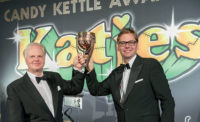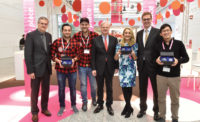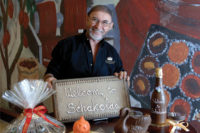Katjes: A pioneer in Potsdam
Faced with a critical need to add capacity in order to sustain a fast-track growth strategy, Katjes Fassin GmbH selects a greenfield site in Potsdam, Germany, to debut the latest in processing efficiency and operational transparency.

It’s not often that a candy manufacturer has a movie star like Tom Cruise doing a film shoot (“Valkyrie”) in its back yard. Nor is it often that a company can decide to select a site and build a greenfield facility “from scratch” in less than nine months, particularly in Germany.
And it’s very rare, indeed, that such an endeavor winds up hiring an all local workforce without any candy processing experience, with more than 70% of them being over 50 years old.
But when you have managing directors such as Tobias Bachmuller and Bastian Fassin running the company, the out of the ordinary tends to be normal. Thus, when it became clear for Katjes Fassin GmbH, the second largest producer of gummies, jellies and chewy candies in Germany, that a third production facility was necessary, the executive team opted to do so in its traditional atypical manner: fast, focused and forward-thinking.
 Having made several brand acquisitions and strategic alliances during the past 10 years, including Villosa in 2000, Frigeo in 2002, Gletscher Eis in 2003, Granini Fruit Candies from Ragolds in 2005 and Lamy Lutti this year, Katjes Fassin has pursued an accelerated growth plan for nearly a decade.
Having made several brand acquisitions and strategic alliances during the past 10 years, including Villosa in 2000, Frigeo in 2002, Gletscher Eis in 2003, Granini Fruit Candies from Ragolds in 2005 and Lamy Lutti this year, Katjes Fassin has pursued an accelerated growth plan for nearly a decade.
Despite having two manufacturing facilities in Emmerich, it became clear prior to the Ragolds’ brand acquisition that hard candy production capacity would be needed. The new facility would also enable the company to move production of certain confectionery products from abroad closer to customers in Germany.
As Bachmuller explains, the company wanted to locate the facility in eastern Germany because of the government subsidies program, which was designed to stimulate economic development in what was the former East German Republic. At the same time, there was also a need to have the plant located close to a major metropolis, thus enabling easy contact with customers.
“At the beginning of 2006, we had no land, no people,” he says. As it turned out, Potsdam, Germany, which adjoins Berlin, proved to be an able partner in helping the company locate a site, providing not only incentives, but a ready labor force.
 The site chosen proved to be a fortuitous one. Not only did it have a rich industrial history behind it – the location previously housed a traditional locomotive production facility, the same one that Tom Cruise used in the movie “Valkyrie” - it happened to sit just a few hundred meters from Babelsberg Film Park.
The site chosen proved to be a fortuitous one. Not only did it have a rich industrial history behind it – the location previously housed a traditional locomotive production facility, the same one that Tom Cruise used in the movie “Valkyrie” - it happened to sit just a few hundred meters from Babelsberg Film Park.
The movie theme park - Europe’s largest - draws 400,000 visitors from April through October each year. Such proximity to a destination draw quickly inspired the idea of having a “transparent” plant, one whereby visitors could see actual candy production from a glass-enclosed mezzanine.
Interestingly, Katjes’ decision to locate the manufacturing facility in Potsdam marked the return of industrial manufacturing to the city, one whose primary economy revolves around government, tourism and service industries.
In designing the 60,300-sq.-ft., €12-million facility, Bachmuller sought to move production of Sallos products, essentially cut-and-wrap licorice items, from Finland to Potsdam.
“The brand’s our biggest seller, having grown 13% last year,” he points out. “But we also wanted to have production of the new Ahoj-Brause Bonbons brand.”
The sticking point was that the two product lines used different processing and packaging methods. Bachmuller questioned the installation of two different lines in a new facility forcing the use of two crews for one shift.
 “2,500 tons annually was not enough to justify two lines,” he explains.
“2,500 tons annually was not enough to justify two lines,” he explains.
As often is the case today with many confectionery companies, Katjes turned to one of its processing equipment partners, Klöckner-Hänsel, to help develop a solution.
“Sallos licorice items are a cut-and-wrap product while the Ahoj-Brause Bonbons featured press-form processing,” Bachmuller explains. “What we wanted was to use the press-form processing technique, but have the items look and taste like cut-and-wrap licorice pieces.”
It wasn’t an easy task, requiring close cooperation between Klöckner-Hänsel and Katjes’ operations and research and development teams. But after several months of testing at Klöckner-Hänsel’s CandyLab facility, the joint effort proved successful.
“Now we’re capable of producing press-formed squares, which we can actually fill with liquid or powder,” Bachmuller notes.
And while he admits the cut-and-wrap process delivered a slightly softer candy, consumers haven’t noticed the textural shift. Moreover, the new processing technique enabled the company to launch an innovative offshoot: Sallos X-treme, licorice squares containing salt inside.
Another key innovation in the installation of the new line involves automation.
“There’s no stopping of production from the kitchen to the packaging line,” he says. “No human hands touch the product until it’s wrapped and placed in the carton. It’s rather revolutionary in the industry.”
 Currently, the company has two shifts turning out 3,500 tons annually. Employing 60 people in total, the Potsdam plant requires the barest minimum in management staffing - plant director, research and development manager, quality assurance manager and production planning manager.
Currently, the company has two shifts turning out 3,500 tons annually. Employing 60 people in total, the Potsdam plant requires the barest minimum in management staffing - plant director, research and development manager, quality assurance manager and production planning manager.
“Everything else, such as human resources, purchasing, supply chain and the like, comes from Emmerich,” Bachmuller says.
Not only has the level of automation delivered improved efficiency and consistency, it’s also enabled the company to tap the local workforce without being hampered by lack of confectionery processing experience.
In this instance, the company was able to hire locals who had been unemployed for at least three years, with nearly 70% of the group 50 years or older.
“Of course, there was a training period involved, and many of them had to get used to our work style, but they have proved to be excellent workers,” he emphasizes. “We’re one of the few companies in Germany who’ve followed this course of action.”
And it’s one that’s paying off. Not only was the company honored by Germany’s Federal Ministry for Labor and Welfare with the “Enterprise with Vision” award, it boosted output by 700 tons after its first full year of production.
A typical candy production run begins with the automatic scaling of ingredients such as water, glucose and sugar, complemented by weighing of minor ingredients such as licorice root, milk powder and fat, all of which are controlled by a micro-processor.
The slurry with all the ingredients is prepared in the Contigrav raw material weighing station in an automated process and with low tolerances. From the reservoir below the Contigrav, the mass is fed by a pump and with a flow control unit to the upstream Crossflow pre-cooker. There, the mass is dissolved and cooked with turbulence and low heat treatment to the required pre-cooking temperature and by a second crossflow to the required final boiling point.
 The boiling temperature (120º - 140º C) and vacuum level is controlled by PLC and kept exactly in the required range. The cooked mass will be evaporated in the upper atmospheric chamber of the Sucroliner and fed down to the vacuum chamber by vacuum. There the mass is extracted by an extraction screw under highest vacuum using newly engineered dynamic mixing screws.
The boiling temperature (120º - 140º C) and vacuum level is controlled by PLC and kept exactly in the required range. The cooked mass will be evaporated in the upper atmospheric chamber of the Sucroliner and fed down to the vacuum chamber by vacuum. There the mass is extracted by an extraction screw under highest vacuum using newly engineered dynamic mixing screws.
Vapor energy is recovered for other heating uses in the plant while water consumption for the vacuum system is also reduced by a clean circulation system.
On the multiple stage tempering belt, the mass is cooled to the exact temperature needed for homogenous forming, with or without filling. From here the mass is fed by a short transportation belt directly to the batch roller of the Strada 1200 chain die forming line for products that can be filled or remain solid. A slinger feeds the mass into the batch roller homogenously, which is required for products that have a high center filling level.
Throughout this time, all key parameters such as humidity, temperature and viscosity are monitored as the mass heads toward the batch roller. Only one person is necessary to supervise the line.
As the rope leaves the batch roller, it proceeds to an in-line former and then to a cooling tunnel where the temperature of the candy pieces drops to 30º C. The pieces are conveyed to one of four Bosch flow wrappers, capable of handling 1,400 pieces a minute. After wrapping, the candies are conveyed to one of two Bosch vertical form/fill/seal baggers. The units can handle 150-gram bags at a rate of 150 bags per minute. The bags then proceed to a cartoning line where packers complete the process, filling the cartons by hand.
“Everything is controlled from a central computer,” says Bachmuller. “In addition, because of the efficiency built into the cooking system, we’re realizing a 10-20% energy savings.”
Katjes’ plans for the facility include adding a second line when sales growth warrants added capacity.
 What makes the automated process perhaps even more fascinating is that it’s all out in the open for visitors to see, necessitating strict adherence to stringent quality and sanitation standards.
What makes the automated process perhaps even more fascinating is that it’s all out in the open for visitors to see, necessitating strict adherence to stringent quality and sanitation standards.
“We were recently audited by the IFS [International Food Standards] and the BRC [British Retail Consortium] and received the highest certification without a single complaint,” Bachmuller asserts.
In addition to making sanitation and quality assurance transparent, the decision to make the facility open to visitors has also provided the company with a new revenue stream, the plant’s retail store.
“In our first full year, we had 220,000 visitors come and visit the plant,” he adds. “We don’t charge anything for the visit, but people do purchase candies in our retail store. I won’t share with you the revenues from the store, except to say they are significant.”
Indeed, after the Sanssouci Palace and the Babelsberg Movie Park, the Katjes plant is the third most visited site in Potsdam. Such popularity has reinforced a closer bond between the city and Katjes.
Last year in mid-June that bond was solidified even more with the announcement by the company that it will donate €55,000 to the reconstruction of the fountains at the Babelsberg Castle. The fountains, which have been silent for 40 years, will return to their full glory, which includes 40-meter geysers shooting upwards. It will also christen the beginning of the complete renovation of the entire Babelsberg Park, which encompasses the famed Babelsberg Palace – the former summer residence of King Wilhelm I and his wife, Augusta.
In a way, the reconstructed fountain reflects what the company has been doing with the brands it has acquired, re-invigorating them to once again make a splash in the marketplace. It’s certainly done that with its new facility in Potsdam.
Sales: $270 million (estimate)
Employees: 500
Plants: 3 (Emmerich – 1; Potsdam – 1; Stuggart - 1)
Products: Licorice, fruit and yogurt gummies, powders.
Brands: Katjes, Sallos, Ahoj-Brause Bonbons, Gletscher Eis, Granni.
Output: 60,000 tons annually
Management: Klaus Fassin, founder and chairman; Bastian Fassin, managing director; Tobias Bachmuller, managing director.

It’s not often that a candy manufacturer has a movie star like Tom Cruise doing a film shoot (“Valkyrie”) in its back yard. Nor is it often that a company can decide to select a site and build a greenfield facility “from scratch” in less than nine months, particularly in Germany.
And it’s very rare, indeed, that such an endeavor winds up hiring an all local workforce without any candy processing experience, with more than 70% of them being over 50 years old.
But when you have managing directors such as Tobias Bachmuller and Bastian Fassin running the company, the out of the ordinary tends to be normal. Thus, when it became clear for Katjes Fassin GmbH, the second largest producer of gummies, jellies and chewy candies in Germany, that a third production facility was necessary, the executive team opted to do so in its traditional atypical manner: fast, focused and forward-thinking.

A night view of the new Potsdam plant, which also houses a retail shop and features free plant tours via a glass mezzanine. In its first year of operation (2008), the free plant tour drew 220,000 visitors.
Despite having two manufacturing facilities in Emmerich, it became clear prior to the Ragolds’ brand acquisition that hard candy production capacity would be needed. The new facility would also enable the company to move production of certain confectionery products from abroad closer to customers in Germany.
As Bachmuller explains, the company wanted to locate the facility in eastern Germany because of the government subsidies program, which was designed to stimulate economic development in what was the former East German Republic. At the same time, there was also a need to have the plant located close to a major metropolis, thus enabling easy contact with customers.
“At the beginning of 2006, we had no land, no people,” he says. As it turned out, Potsdam, Germany, which adjoins Berlin, proved to be an able partner in helping the company locate a site, providing not only incentives, but a ready labor force.

The movie theme park - Europe’s largest - draws 400,000 visitors from April through October each year. Such proximity to a destination draw quickly inspired the idea of having a “transparent” plant, one whereby visitors could see actual candy production from a glass-enclosed mezzanine.
Interestingly, Katjes’ decision to locate the manufacturing facility in Potsdam marked the return of industrial manufacturing to the city, one whose primary economy revolves around government, tourism and service industries.
In designing the 60,300-sq.-ft., €12-million facility, Bachmuller sought to move production of Sallos products, essentially cut-and-wrap licorice items, from Finland to Potsdam.
“The brand’s our biggest seller, having grown 13% last year,” he points out. “But we also wanted to have production of the new Ahoj-Brause Bonbons brand.”
The sticking point was that the two product lines used different processing and packaging methods. Bachmuller questioned the installation of two different lines in a new facility forcing the use of two crews for one shift.

Quality assurance manager Julia Sailer performs quantitative analysis tests daily on products run in the plant.
As often is the case today with many confectionery companies, Katjes turned to one of its processing equipment partners, Klöckner-Hänsel, to help develop a solution.
“Sallos licorice items are a cut-and-wrap product while the Ahoj-Brause Bonbons featured press-form processing,” Bachmuller explains. “What we wanted was to use the press-form processing technique, but have the items look and taste like cut-and-wrap licorice pieces.”
It wasn’t an easy task, requiring close cooperation between Klöckner-Hänsel and Katjes’ operations and research and development teams. But after several months of testing at Klöckner-Hänsel’s CandyLab facility, the joint effort proved successful.
“Now we’re capable of producing press-formed squares, which we can actually fill with liquid or powder,” Bachmuller notes.
And while he admits the cut-and-wrap process delivered a slightly softer candy, consumers haven’t noticed the textural shift. Moreover, the new processing technique enabled the company to launch an innovative offshoot: Sallos X-treme, licorice squares containing salt inside.
Another key innovation in the installation of the new line involves automation.
“There’s no stopping of production from the kitchen to the packaging line,” he says. “No human hands touch the product until it’s wrapped and placed in the carton. It’s rather revolutionary in the industry.”

(L. to r.) Plant director Manfred Kappler explains the Contigrav raw material weighing station that automatically scales ingredients precisely. After cooking, the mass is extracted onto a cooling belt. A slinger then feeds the mass to a batch roller, which in turn, feeds a Strada 1200 chain die former. Upon leaving the former, the licorice pieces head toward a cooling tunnel before moving onto packaging.
“Everything else, such as human resources, purchasing, supply chain and the like, comes from Emmerich,” Bachmuller says.
Not only has the level of automation delivered improved efficiency and consistency, it’s also enabled the company to tap the local workforce without being hampered by lack of confectionery processing experience.
In this instance, the company was able to hire locals who had been unemployed for at least three years, with nearly 70% of the group 50 years or older.
“Of course, there was a training period involved, and many of them had to get used to our work style, but they have proved to be excellent workers,” he emphasizes. “We’re one of the few companies in Germany who’ve followed this course of action.”
And it’s one that’s paying off. Not only was the company honored by Germany’s Federal Ministry for Labor and Welfare with the “Enterprise with Vision” award, it boosted output by 700 tons after its first full year of production.
A typical candy production run begins with the automatic scaling of ingredients such as water, glucose and sugar, complemented by weighing of minor ingredients such as licorice root, milk powder and fat, all of which are controlled by a micro-processor.
The slurry with all the ingredients is prepared in the Contigrav raw material weighing station in an automated process and with low tolerances. From the reservoir below the Contigrav, the mass is fed by a pump and with a flow control unit to the upstream Crossflow pre-cooker. There, the mass is dissolved and cooked with turbulence and low heat treatment to the required pre-cooking temperature and by a second crossflow to the required final boiling point.

The new die forming line offers added flexibility for Katjes, allowing production of both solid and/or filled (liquid or powder) items.
Vapor energy is recovered for other heating uses in the plant while water consumption for the vacuum system is also reduced by a clean circulation system.
On the multiple stage tempering belt, the mass is cooled to the exact temperature needed for homogenous forming, with or without filling. From here the mass is fed by a short transportation belt directly to the batch roller of the Strada 1200 chain die forming line for products that can be filled or remain solid. A slinger feeds the mass into the batch roller homogenously, which is required for products that have a high center filling level.
Throughout this time, all key parameters such as humidity, temperature and viscosity are monitored as the mass heads toward the batch roller. Only one person is necessary to supervise the line.
As the rope leaves the batch roller, it proceeds to an in-line former and then to a cooling tunnel where the temperature of the candy pieces drops to 30º C. The pieces are conveyed to one of four Bosch flow wrappers, capable of handling 1,400 pieces a minute. After wrapping, the candies are conveyed to one of two Bosch vertical form/fill/seal baggers. The units can handle 150-gram bags at a rate of 150 bags per minute. The bags then proceed to a cartoning line where packers complete the process, filling the cartons by hand.
“Everything is controlled from a central computer,” says Bachmuller. “In addition, because of the efficiency built into the cooking system, we’re realizing a 10-20% energy savings.”
Katjes’ plans for the facility include adding a second line when sales growth warrants added capacity.

After cooling, the Sallos licorice pieces travel toward one of four Bosch flow wrappers capable of handling 1,400 pieces per minute. The wrapped licorice pieces are conveyed toward one of two Bosch form/fill/seal baggers, which can pack 150-gram bags at a rate of 150 bags per minute. Then bags then head toward a manual packing line where employees hand pack the bags into cartons.
“We were recently audited by the IFS [International Food Standards] and the BRC [British Retail Consortium] and received the highest certification without a single complaint,” Bachmuller asserts.
In addition to making sanitation and quality assurance transparent, the decision to make the facility open to visitors has also provided the company with a new revenue stream, the plant’s retail store.
“In our first full year, we had 220,000 visitors come and visit the plant,” he adds. “We don’t charge anything for the visit, but people do purchase candies in our retail store. I won’t share with you the revenues from the store, except to say they are significant.”
Indeed, after the Sanssouci Palace and the Babelsberg Movie Park, the Katjes plant is the third most visited site in Potsdam. Such popularity has reinforced a closer bond between the city and Katjes.
Last year in mid-June that bond was solidified even more with the announcement by the company that it will donate €55,000 to the reconstruction of the fountains at the Babelsberg Castle. The fountains, which have been silent for 40 years, will return to their full glory, which includes 40-meter geysers shooting upwards. It will also christen the beginning of the complete renovation of the entire Babelsberg Park, which encompasses the famed Babelsberg Palace – the former summer residence of King Wilhelm I and his wife, Augusta.
In a way, the reconstructed fountain reflects what the company has been doing with the brands it has acquired, re-invigorating them to once again make a splash in the marketplace. It’s certainly done that with its new facility in Potsdam.
At a glance
Headquarter: Emmerich, GermanySales: $270 million (estimate)
Employees: 500
Plants: 3 (Emmerich – 1; Potsdam – 1; Stuggart - 1)
Products: Licorice, fruit and yogurt gummies, powders.
Brands: Katjes, Sallos, Ahoj-Brause Bonbons, Gletscher Eis, Granni.
Output: 60,000 tons annually
Management: Klaus Fassin, founder and chairman; Bastian Fassin, managing director; Tobias Bachmuller, managing director.
Looking for a reprint of this article?
From high-res PDFs to custom plaques, order your copy today!








